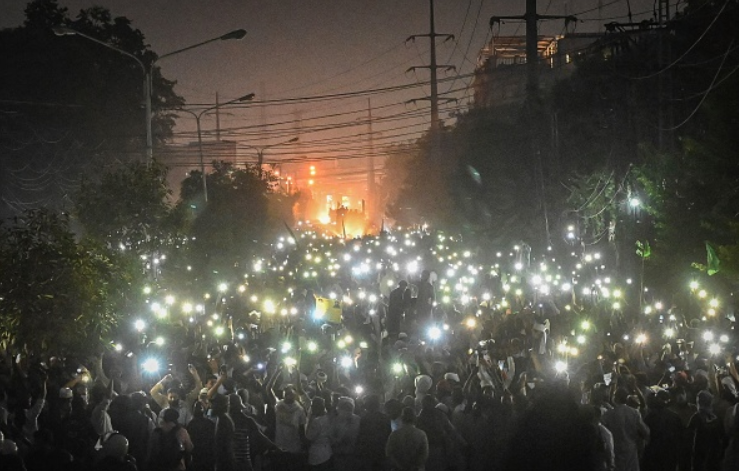
The number of internet users in Pakistan has continued to skyrocket—growing by 11 million users between 2020 and 2021 alone. As observers of the digital world are well aware, while expanding internet access can spur economic development it has also fueled the growth of extremist sentiment. One such challenge in Pakistan has come from rise of the Tehreek-e-Labbaik Pakistan (TLP). Over the years, there have been recurrent violent protests from the TLP and is followers including one in October 2021—during which four police were killed and over 250 were injured—and the lynching of Sri Lankan national Priyantha Kumara in Sialkot after a mob falsely accused him of blasphemy. The TLP denied links to the brutal act, but the slogans shouted at the crime scene echoed those of the extremist political group.
The TLP’s basic tactics have relied on mass mobilization and the use violence against state authorities, including police personnel, public, and private property. The TLP has mobilized support around the highly sensitive issue of blasphemy in Pakistan, without sound counter response from the government. The government has taken a stop-start approach to the TLP, best demonstrated by attempts to enter into various agreements that often leave the TLP feeling more emboldened than before. Meanwhile, the use of violence in large scale mass protests is posing a challenge to state’s writ and reflects a the troubling trend of online radicalism with the TLP building its political support with the help of its rising digital reach. Without concrete action, the challenges faced by Pakistan from the TLP’s violent politics and promotion of extremism online—including further protests or potential self-censorship among mainstream Islamic scholars and critics—will continue in the year ahead.
Social Media, Radicalization, and Hate Speech
The TLP has built considerable traction since its first major protest of the PML-N government over a controversial amendment to the candidate oath in the Elections Act 2017—which the government subsequently withdrew in parliament. During these protests the group effectively used social media to reach out to its audience. Since the 2017 sit-in and violent protests, social media has been a crucial tool for the TLP to expand its political base.
Without concrete action, the challenges faced by Pakistan from the TLP’s violent politics and promotion of extremism online—including further protests or potential self-censorship among mainstream Islamic scholars and critics—will continue in the year ahead.
The TLP’s rise on social media has aligned with a rapidly rising rate of internet users in Pakistan. In 2018, the Pakistan Telecom Authority reported approximately 59 million mobile internet users (3G and 4G subscribers)—approximately 28 percent of the population. By December 2021, these figures had risen by 83 percent to 108 million and 49.04 percent of the total population. During this period, the TLP has also gained a strong foothold in digital spaces. The use of social media platforms, especially YouTube, has become a potent instrument for pushing its message to domestic users. As global platforms, the TLP may also find traction abroad in the South Asian diaspora. Affordability and accessibility of smart phones across Pakistan has made it convenient for growing number users to access YouTube and other social media platforms.
The access also ensured the downside on such platforms: exposure, at times, to unfiltered hate speech. Often time exposure to such content is made with almost effortless with algorithms that push videos with clickbait designed thumbnails on YouTube’s homepage or recommended content. The “YouTube Project” a research study by Mozilla Foundation has also corroborated similar findings from 91 countries around the world. The study found that YouTube algorithms were often recommending videos containing hate speech, violence, and misinformation—violating YouTube’s own policies—to users.
The TLP has strategically employed YouTube for political and religious outreach, to stay connected and reach out to its base to join ranks during protests—often taking a violent course. Beyond YouTube, the TLP has also relied on Twitter and Facebook. During the violent protests in October 2021 it created trending content over Twitter—often amplified with aid from trolls—without much action from platforms to remove such content. Systemic issues, such as shortage of local dialect speakers, at Facebook (now Meta) have also allowed disinformation, hate speech and violent extremism to go unchecked over the platform across different parts of the world, including South Asia. This digital reach has complemented the TLP’s “street power” allowing it to seize and exert influence politically and through violence.
Bridging the Digital and Physical Divide to Counter Violent Extremism
In 2018, the PML-N government issued a fatwa (a religious opinion) Paigham-e-Pakistan by soliciting opinions from senior and credible Islamic scholars from across the country. The declaration of the fatwa prohibited use of violence by any non-state entity in the name of Islam; it called for criminal action against the use of media and physical spaces, including mosques, for promoting hate speech. However, the document lacks parliamentary endorsement. There has recently been a renewed discussion of the document’s endorsement, and adopting legislation consistent with policy goals of Paigham-e-Pakistan could create a more holistic approach to violent extremism: including the need to develop a national narrative. The unchecked proliferation of content over social media, however, shows the challenges ahead. In the case of Priyantha Kumara, only one perpetrator was found guilty and sentenced to one-year in prison with PKR 10,000 (approximately USD $56) for justifying the lynching on YouTube. The trial of those involved in lynching remains ongoing.

Efforts by the government towards countering hate speech or radicalization have largely been disjointed and raised concerns over media censorship and surveillance. Previous agreements between the government and the TLP have lacked the decisive action needed and allowed violence to surface time and again. The government’s approach has been mostly centered on applying half-hearted enforcement measures against the TLP. Most importantly, this enabled the diffusion and adoption of intolerant content across digital ecosystems. During nearly every TLP protest, the government has responded with internet shutdowns. While these reactive approaches offer a short term and local reprieve, they fall short of a durable solution and also deny accessibility to millions of affected users. Meanwhile, the approach towards removal of hate speech and online content has lacked clarity and run into judicial impasses.
The government’s internet laws have been challenged in the Islamabad High Court over the risks of censorship and limits of free speech, with primary concerns from journalists and activists. The laws included Citizen Protection (Against Online Harm) Rules 2020 and later Removal and Blocking of Unlawful Online Content Rules 2020 were introduced under Prevention of Electronic Crimes Act 2016 and Pakistan Telecommunication Authority Act 1996. Notwithstanding the legal logjam faced by the rules and significant free speech concerns, the regulations also set up a coercive approach towards social media platforms—requiring companies to establish offices inside Pakistan and remove any content that was flagged or else risk being blocked. Relying on such an approach will only prevent significant investments from social media companies and internet-intermediary firms in country’s nascent tech space.
During nearly every TLP protest, the government has responded with internet shutdowns. While these reactive approaches offer a short term and local reprieve, they fall short of a durable solution and also deny accessibility to millions of affected users.
With the digital media space expanding in Pakistan, it is important for the country to take an inclusive and collaborative approach towards social media entities. To this end the Asia Internet Coalition, a conglomerate of social media companies, has consistently expressed interest in adopting a similar collaborative approach as the one followed by New Zealand and United Kingdom on content removal. This approach under “Christchurch Call” requires development of tools preventing uploading of such content; tackling roots of violent terrorism; improving transparency on content removal; and reviewing platform algorithms directing users to such content. Unlike the challenged policies in Pakistan, this takes a proactive rather than a firefighting approach to online extremism. While Pakistan can tailor make its approach with social media entities; an incremental approach to draw companies to Pakistan for corporate investment and presence is still needed. As a more collaborative approach can start to address both Pakistan’s online extremism challenges and the risks of more reactive and severe laws.
Countering extremism in online spaces requires coordinated and integrated approach by the state. Taking inspiration from the new National Security Policy (NSP) a holistic framework for countering threat of hybrid extremism can be developed in the online and physical domain. A more proactive approach with pronounced ownership from state to different organs of the state is required: media, educational institutes, mosques and religious institutes, law enforcement agencies and government to bring the threat of extremism under control. Violent form of politics from the TLP, despite participating in elections, could remain a challenge for the state in 2022; which requires a long-term, nuanced, and less confrontational approach—consistent with the goals of the new NSP. Only such an approach will overcome the hybrid challenge of extremism.
***
Image 1: ARIF ALI/AFP via Getty Images
Image 2: ARIF ALI/AFP via Getty Images


